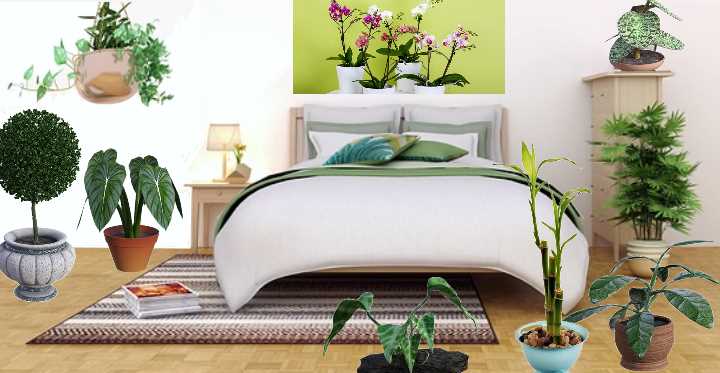A natural, peaceful, and relaxin environment may be created with a few well-chosen plants in your bedroom. Houseplants that flourish in low-light and need minimal care are often the best bedroom plants. Peace lilies and orchids, for example, are flowering plants that add beauty to your bedroom. Pothos, ferns, and hoyas are some of the best trailing indoor plants for hanging baskets.
Several plants that are good for bedroom air purification may also be used. Leafy houseplants, in addition, release moisture and aid to humidify the atmosphere. The health benefits of clean, humid air versus dry, polluted air are substantial. Of course, you may place any kind of potted indoor plant in your room.
However, certain plants prefer the bedroom environment over others. Cacti, succulents, and plants with vivid blossoms may be able to survive in bedrooms if you place them correctly, but they will not last long. These plants thrive in bright light and will begin to look unwell if it isn’t enough.
The finest plants for your bedroom, as well as why they’re suitable, are discussed in this article. In order to get inspiration for your bedroom décor, take a look at the photos of these bedroom plants. Let’s explore why plants are valuable in your bedroom before we investigate which ones are finest for the room you sleep in.
The Best Air-Purifying Bedroom Plants According to NASA
Most people are aware that living things, such as plants, respire or breathe. Photosynthesis, which is carried out by plants throughout the day, absorbs carbon dioxide and releases oxygen. The process reverses in the evening and nighttime when there is little or no light: plants “breathe in” oxygen and exhale carbon dioxide. Can basic houseplants really clean the air?
NASA conducted tests to see if certain plants can clean air in the home. Leafy green plants, according to scientists, may remove contaminants from the air in addition to releasing oxygen. Benzene, formaldehyde, and trichloroethylene were among the volatile organic compounds that houseplants helped to filter from the air. (1)
What are the best air-purifying plants for your bedroom? NASA identified the following ten best bedroom plants:
- English ivy (Hedera helix) For the bedroom, it’s a great hanging plant.
- Peace lily (Spathiphyllum) It has lovely blossoms and may help to improve indoor air quality.
- Philodendron hanging baskets are made from this beautiful vine plant.
- Cornstalk dracaena (Dracaena fragrans)
- Golden pothos (Epipremnum aureum) a leafy green vine plant that is lovely
- Mother-in-law’s tongue (Sansevieria) – This easy-to-care plant is also known as the snake plant because of its filtering properties.
- Gerbera daisies –For your bedroom, you can’t go wrong with a beautiful flowering plant.
- Indoor banana plants (Musa Oriana)
- Green spider plant (Chlorophytum elatum)
- Chinese evergreen (Aglaonema modestum)
Flowering plants for bedrooms include peace lilies and gerbera daisies, hanging basket plants include spider plants, English ivy, and golden pothos, and leafy green plants include ferns.
Bedroom Plants and Oxygen
You shouldn’t be concerned about how many plants in your room might affect oxygen levels. Yet, despite the fact that plants emit carbon dioxide at night, the quantities are low and will have no impact on your sleeping habits. Orchids and succulents, for example, release oxygen during the evening.
Placing houseplants in your bedroom has a lot of advantages. Plants in your home have been shown to decrease stress, lower blood pressure, and boost feelings of calmness, not just can they help purify the air.
The Best Bedroom Plants (With Pictures)
What are some of the best plants and flowers to have in your bedroom now that you know the benefits of doing so? Read on to learn which plants thrive in low-light or dark conditions.
Peace Lily (Spathiphyllum)
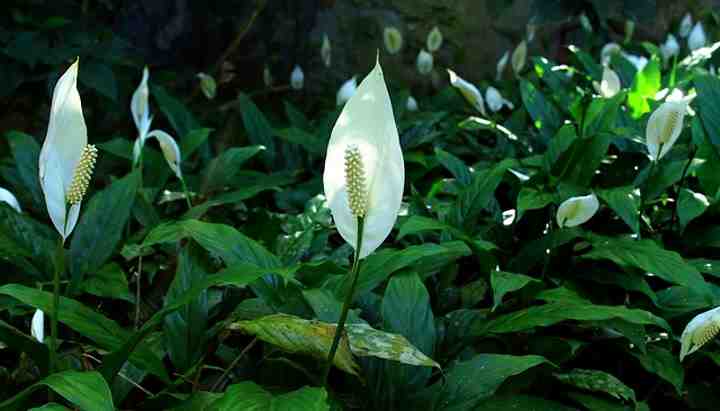
Peace lilies are a fantastic blooming plant that thrives in low light and requires very little attention. They are ideal for any bedroom. Dark corners in any room can be brightened up with the beautiful white flowers and bright glossy green foliage. These “lilies” might assist generate sensations of peace, seclusion, and calmness, as their name suggests. The flower of peace lilies isn’t really a lily.
The spathe flowers are white and belong to the same family as monstera plants (Swiss cheese plants). In bright or dim light, peace lilies thrive equally. If there isn’t any direct sunlight, putting your peace lily inside your bedroom window will help it bloom on a regular basis.
Snake Plants (Sansevieria)

Mother-in-law’s tongue, or the popular name for a number of sansevierias, is another excellent plant for your bedroom. Snake plants were ranked among the best air-purifying plants for residences, according to a NASA research. Sansevieria plants are drought tolerant and require little upkeep, requiring minimal lighting and water.
Keeping a sansevieria in your bedroom, or any other area, is simple. Pruning is not required for this non-fussy plant. Some people believe that the neglect shown to this bedroom plant is beneficial. Nonetheless, the plant will provide you with long, succulent green and yellow leaves if you give it little care. The leaves, which may reach a height of 28 to 35 inches (70 to 90 cm), are long and tapering.
Golden Pothos (Hanging Plant to Keep in Your Bedroom)

Golden pothos are a great option for a hanging basket if you want an easy bedroom plant. The variegated leaves, which are golden yellow and green, give it its popular name. Hanging in a dim corner or putting on a high shelf, the long trailing brightly-colored stems are lovely.
The golden pothos grows well under most circumstances and is sometimes known as devil’s ivy. While the vibrant foliage on this vine bedroom plant thrives in bright indirect light, it will also grow well in dim lighting.
Pothos is a kind of plant that cleans the air in your room by removing airborne contaminants, according to NASA. Golden pothos is one of the plants that thrives in sealed glass containers alongside other tropical plants if you have a terrarium in your bedroom. Only water when the soil is partly dry, as with most houseplants that grow in moderate to low light.
Spider Plant (Chlorophytum comosum)

If you want a hanging basket plant that both cleans the air and is aesthetically pleasing, spider plants are the “go-to.” The cheery foliage of the spider plant appears to be a cascade of thin leaves in a field of green and white. Any room in the bedroom, bathroom, or north-facing room can be brightened up with the arching ribbon-like leaves.
This easy-going bedroom plant does not need to be grown in a hanging basket. On a dresser, bedside table, or bookshelf, the potted plant will look just as nice. Spider plants are nearly maintenance-free, and you may almost forget about them. These drought-tolerant plants may survive for many years without water and are happy to be kept in a dark room.
English Ivy (Hedera helix)

English ivy is a bushy vine plant with long stems and deeply-lobed leaves that makes a wonderful hanging basket in your bedroom. Since the vines grow quite long, you’ll need a lot of vertical space in the bedroom corner. alternatively, train the vines to grow upward as a decorative accent by putting a moss pole in the pot.
Vigorous development is aided by the use of bright illumination. English ivy will grow well even if your room isn’t too bright. The “Gold Child” cultivar with yellow-gold and green foliage or a variety of ivy with lush, variegated green and creamy white leaves can liven up a room.
Arrowhead Plant (Syngonium podophyllum)

Arrowhead plants thrive in nearly any room in the house, whether it’s dimly-lit or brightly-lit. Syngonium podophyllum ‘Emerald Green’ is one of them. Pick a deep-green arrowhead cultivar if your bedroom isn’t getting a lot of natural sunlight. In low light, these plants appear to perform better.
The leaves of the broadleaf indoor plant form an arrowhead shape. Glossy green leaves are seen in some cultivars, white streaks are seen in others, and variegated lime-green and cream-colored leaves are visible in others.
Hanging these plants high up is the finest technique to match your bedroom decor. The hanging basket will have long trailing vines that stretch up to 6 feet (1.8 meters) from the ground. Just keep in mind that if the sap comes into touch with the skin, arrowhead plants might cause skin irritation and burning.
Dracaena (Dracaena deremensis) – Bedroom Tree
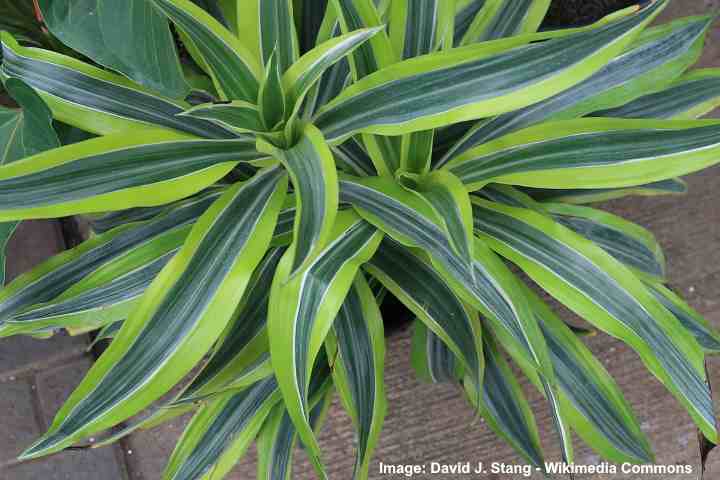
Dracanea cultivars such as Janet Craig or Warneckii dracaena are low-maintenance aesthetic plants that make a excellent indoor bedroom tree option. On the top of thin woody stalks, the plant has narrow, ribbon-like leaves that give it a spiked look. The plant can grow to be several feet tall, and it may add a lush look to any shady spot. Because they don’t need much water and can survive in low light, dracaena plants are popular houseplants.
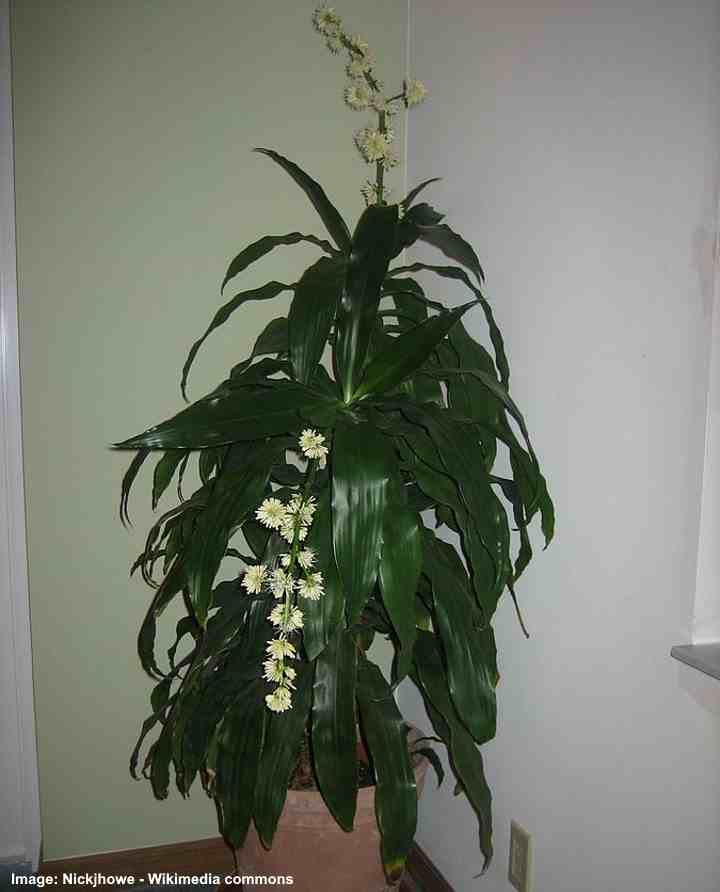
Dracaena Deremensis ‘Janet Craig’
Happy Plant (Dracaena fragrans)
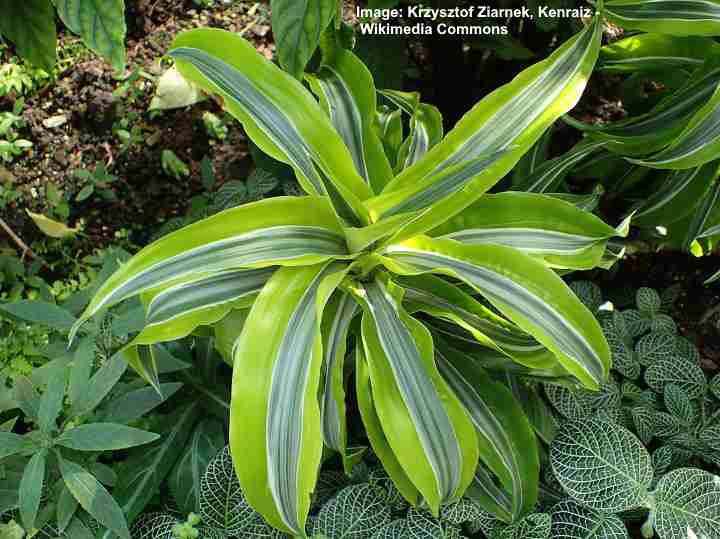
Another tropical leafy indoor tree that is ideal for your bedroom is Dracaena fragrans, also known as the happy plant or cornstalk plant. The stalk and foliage of this species are typically broader and bushy, as compared to the Janet Craig. What little light there is in the room will be reflected by the shiny glossy leaves.
Happy plants thrive in low-light, occasional watering environments similar to those found in other dragon tree (Dracaenas) species’ bedrooms.
Chinese Evergreen (Aglaonema)

One of the most popular indoor plants is Chinese evergreen. In low light, the large green and white or silver leaves thrive on their own, requiring little upkeep. Chinese evergreens are considered to be among the lucky plants in Asia. Just a warm, humid atmosphere and occasional artificial or natural light are required for this attractive indoor aesthetic plant.
Light-colored leaves need more sunlight than dark-colored leaves, as with most houseplants with variegated foliage. As a result, in rooms with south-facing windows where they get plenty of bright light, some Chinese evergreens may perform better. In dim rooms, cultivars with darker-green leaves will thrive.
Wax Flower Plant (Hoya carnosa)
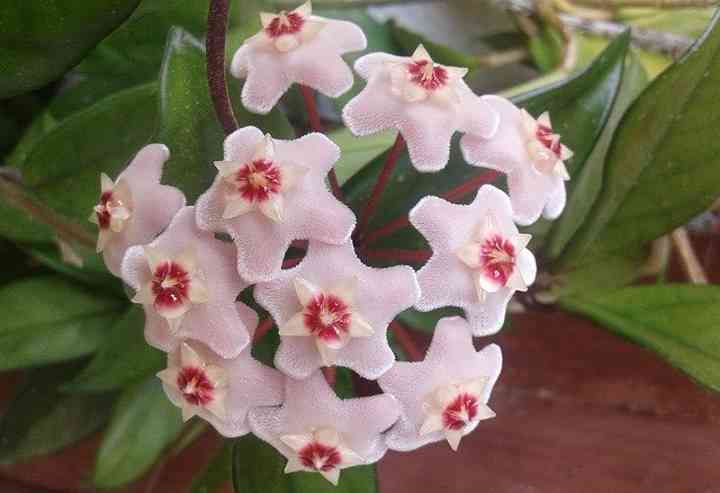
This hoya species is also known as the porcelain-flower plant and is a quiet bedroom plant that requires little care. Because the succulent leaves hold moisture, you don’t need to water this plant often. Hoyas may endure in dimmer environments than other species, although they favor bright, indirect light.
This plant is an ideal choice for a colorful bedroom hanging basket because the wax flower vine grows on trailing vines. Or, if you have the time, you can assist the hoya grow upright by training it. Your hoya may develop exquisite porcelain flowers to brighten up your room if the correct conditions are met.
Dumb Canes (Dieffenbachia)

Deffenbachia cv. ‘Bausei’ is a popular houseplant that thrives in almost any environment, from dimly-lit rooms to brightly-lit areas. Dumb canes, on the other hand, are forgiving even in low light. The most important thing is to keep the large oval leaves out of the sun.
Green leaves with creamy or yellowish patches are seen on these simple-to-raise houseplants. Dumb canes are great for placing in an empty bedroom wall or in a shady corner since they grow upright. Without the need for flowers, the bright leaves give any room added texture and color.
Low-Light Orchid Flowers

Have an orchid in your bedroom if you want gorgeous uncommon flowers. Most houseplant orchids are simple to maintain and require little care. Orchids like Phalaenopsis and Lady’s Slipper flourish in dark areas of your house, such as bedrooms, and are therefore suitable for this.
These orchids only need a little care and can thrive in room temperatures of about 80 degrees Fahrenheit. Many orchids prefer the dark, humid environment of tropical rainforests in their native habitat.
Maidenhair Fern (Adiantum)

In dark settings such as a bathroom with no windows, maidenhair ferns cannot grow. They are ideal for north-facing rooms and bedrooms with low to moderate illumination, however. They’ll do even better if they get some morning or afternoon sunlight.
The delicate gorgeous leaves of maidenhair ferns are prized by many people. Little delicate green leaves sprout from the slender arching stems. These ferns, on the other hand, are difficult to care for and do not require a lot of upkeep.
Peperomia as a Bedroom Plant

Because of their preference for shade and moderate light, peperomias make ideal bedroom plants. Their leaves may lose some of their brightness in low-light settings. Peperomia has a wide range of species, each with distinct leaf patterns. Before watering, you usually have to leave the land to dry out.
These tiny houseplants, also known as radiator plants, are ideal for small, shaded areas. Certain peperomia types feature thick glossy green leaves, others feature green striped designs, and others feature heart-shaped purple leaves with prominent veins.
Parlor Palm (Chamaedorea elegans)

The parlor palm is a beautiful houseplant that grows like a tiny tree or palm, as its scientific name implies. One of the most popular indoor palm plants in the world is this palm. The parlor palm can adapt to a variety of settings in your home. The leafy palm should be kept away from direct sunlight since it tolerates low light and low humidity.
A parlor palm thrives on the combination of light and artificial light in your bedroom. Parlor palms reach a height of 3 to 4 feet (0.9 to 1.2 meters) indoors. It will take years for this plant to reach its full height because it is a slow-growing plant.
Fiddle Leaf Fig (Ficus lyrata)

In your bedroom or other large portions of your home, this popular decorative tree may be grown in a pot. The indoor tree thrives on some natural, indirect sunlight, despite its shady location. The large, glossy leaves provide a tropical feel to your bedroom and are reminiscent of lush leaves.
It’s vital to maintain the water, humidity, and temperature in your ficus plant indoors just right. In poor to faint lighting situations, this kind of fig tree may struggle to thrive. The weeping fig tree (Ficus benjamina) is a small ficus tree that would work well in a bedroom that gets little light. This ficus tree thrives in low light and looks good against a bedroom wall or in a dim corner.

Ficus benjamina
Bedroom Plants and Feng Shui
If you follow Feng Shui principles, it’s generally not advised to keep plants in bedrooms. Because plants symbolize active development rather than calm repose and contemplation, Feng Shui and bedroom plants don’t mix. Yet, others notice that peace lilies, for example, may bring calm to a small bedroom environment.
A palm in the corner, far from your bed, should be permissible if you have a particularly huge bedroom.
